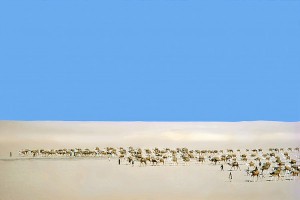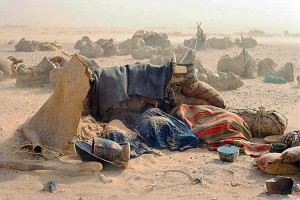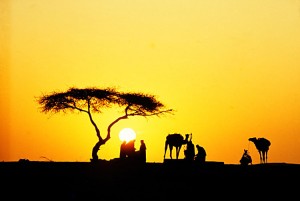I’m the sole photographer of 17 photo books, a few of which I wrote. My favorite is Wind, Sand and Silence: Travels with Africa’s Last Nomads, published in 1992 by Chronicle Books. It’s a revised and expanded compilation of five illustrated articles I did many years ago for National Geographic. Two chapters are on the Sahara’s Tuareg–on daily camp life and a salt caravan. The other three are on the Wodaabe of Niger, the Danakil of Ethiopia, and the Turkana of Kenya.
That book was among nine that Time magazine recommended in its 1992 Christmas issue. It also earned the Chicago Geographical Society’s 1992 Publication Award. But this is not why I like it best. In fact, I lament its poor printing quality and loathe its design, which grossly cropped many of my pictures, which I had carefully composed in the viewfinder. But, I treasure my book on nomads best, in spite of its shortcomings, because of the people and journeys it documents. I love nomads and their ways of life.
Perhaps because I am at heart a nomad myself. I’ve lived and worked in six countries. And many of my travels have involved hiking with pack donkeys or llamas, or riding camels or horses, for weeks and even months on end, always through fence-less desert, savanna, mountains, or forest. (And I’ve learned a few high-risk photography tips along the way.)
Traveling that way makes it possible to hear the birds sing, to breathe and smell the fragrant air, and to appreciate the changing scenery. Besides, sleeping under the stars and waking every morning in a different spot beats always waking across from the same picture on the wall.
Here are three tips on getting the right images, when you’re out shooting photos for a coffee table book like this:
Tip # 1 : Think in terms of the story: A coffee table book is like any other book: it needs a beginning, middle, and end. The beginning must grab the viewer’s interest. As much as possible it must be a distillation of the story that follows. The end makes evident that the story has come to a conclusion. The middle is obviously the filling. Taking the example of the salt caravan, I had plenty of time during the month-long journey to take many suitable pictures to fill those three roles and give the editor a choice to work with. Below you’ll see three pictures National Geographic used, including the ones that begin and end the story.
Sometimes, however, I have had only a day or two to shoot a story. And so little was happening that, unless I took things into my own hands, I would end up with no story. Make sure you research your subject and have a plan B. If nothing dramatic enough happened while I was shooting, I would set some shots up myself.
It’s important to understand the purpose of your book is to convey your story in an accurate manner. Keep in mind, however, that it is your photographic interpretation of how to tell the story. You are the editor deciding what to include and exclude and how to best get your vision across to the reader. Sometimes that may mean reshooting something you missed or resetting to improve the lighting.
Tip # 2 : Be flexible Get a good idea of what you’ll be shooting. However, be open to anything. Things do not always happen as expected. Always be aware of, and understand, what is happening around you. If you miss an important picture, request that the situation be recreated for you.
Tip # 3 : Cover all angles There are many angles to every subject. Be sure to cover as many as possible and to shoot vertical as well as horizontal pictures. The art director will thank you for giving her enough material to play with.
Travel Photography Resources
5 Dos and 2 Don’ts for Travel Photography
Take Great Photos And Get Paid More For Your Travel Articles
Turning a Photography Hobby into a Monthly Income
The Pros Of Selling Your Images As Stock Photography
16 Mobile Photography Tips And Tricks Every Photographer Should Know




